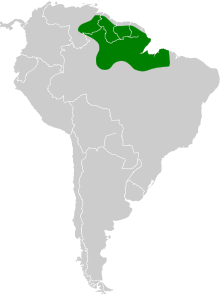Crimson topaz
The crimson topaz (Topaza pella) is a species of hummingbird in the family Trochilidae.
| Crimson topaz | |
|---|---|
.jpg) | |
| Scientific classification | |
| Kingdom: | Animalia |
| Phylum: | Chordata |
| Class: | Aves |
| Order: | Apodiformes |
| Family: | Trochilidae |
| Genus: | Topaza |
| Species: | T. pella |
| Binomial name | |
| Topaza pella | |
 | |
| Distribution of Topaza pella | |
| Synonyms | |
Subspecies
Distribution
This species can be found in Brazil, Colombia, French Guiana, Guyana, Peru, Suriname, and Venezuela.[1][2]
Habitat
Its natural habitat is subtropical or tropical moist lowland forest up to 500 m.[2] They live in the upper and middle canopy, and are rarely seen on the ground.
Description
Topaza pella can reach a length of 21–23 centimetres (8.3–9.1 in) in males (including bill abt. 5 cm and tail abt. 12 cm), while females reach 13–14 centimetres (5.1–5.5 in).[2] Both males and females weigh about 10 grams. It may be the second largest species of hummingbird after the giant hummingbird.
The male crimson topaz is notably larger and, with iridescent crimson plumage and sparkling green throat, more spectacular-looking than the female. Belly and breast are metallic orange-red. The wings are brown and are maroon in the lower part. The long tail coverts are golden green. They have short, slightly curved beaks that allow them to feed from a variety of local plants.[4]
Biology
These hummingbirds mainly feed on nectar of flowering trees in the canopy of the forest (Bromeliaceae and Ericaceae).[2][4]
Bibliography
- Arthur Lennox Butler: Mr. A. L. Butler exhibited some examples of Topaza pella which he had recently received from the neighbourhood of Pará. In: Bulletin of the British Ornithologists' Club. Bd. 46, 1926, S. 56–57 (online [abgerufen am 19. Juni 2014]).
- Carl von Linné: Systema Naturae per Regna Tria Naturae, Secundum Classes, Ordines, Genera, Species, Cum Characteribus, Differentiis, Synonymis, Locis. 10. Auflage. Bd. 1. Imprensis Direct Laurentii Salvii, Stockholm 1758
- Da-Shih Hu, Leo Joseph, David Agro: Distribution, Variation, and Taxonomy of Topaza Hummingbirds (Aves: Trochilidae). In: Ornitologia Neotropical. Bd. 11, Nr. 2, 2000, S. 123–142
- George Robert Gray: A list of the genera of birds: with their synonyma an indication of the typical species of each genus. Compiled from various sources. Richard and John E. Taylor, London 1840
- Harry Church Oberholser: Catalogue of a collection of hummingbirds from Ecuador and Colombia. In: Proceedings of the United States National Museum. Bd. 24, 1902, S. 309–342
- James A. Jobling: Helm Dictionary of Scientific Bird Names. Christopher Helm, London 2010, ISBN 978-1-4081-2501-4.
- Louis Augustin Guillaume Bosc: Description d'une nouvelle espèce de Grimpereau. In: Journal d'histoire naturelle. Bd. 1, 1792, S. 385–386, Tafel 20, Abbildung 5
- Robert Sterling Ridgely, Paul J. Greenfield: Birds of Ecuador Field Guide: Field Guide. Bd. 2. Princeton University Press, Princeton 2001, ISBN 978-0-8014-8721-7.
- Rolf Grantsau: Die Kolibris Brasiliens. Expressão e Cultura, Rio de Janeiro 1988, ISBN 978-85-208-0101-7.
- Steven Leon Hilty, William Leroy Brown: A guide to the birds of Colombia. Princeton University Press, Princeton 1986, ISBN 978-0-691-08372-8.
- del Hoyo, J., Collar, N.J., Christie, D.A., Elliott, A. and Fishpool, L.D.C. 2014. HBW and BirdLife International Illustrated Checklist of the Birds of the World. Lynx Edicions BirdLife International.
References
- BirdLife International (2016). "Topaza pella". IUCN Red List of Threatened Species. 2016: e.T22687759A93168003. Retrieved 5 March 2020.CS1 maint: ref=harv (link)
- Schuchmann, K.L., Kirwan, G.M. & Boesman, P. (2016). Handbook of the Birds of the World Alive. Lynx Edicions, Barcelona
- IOC World Bird Names
- Oiseaux-birds
